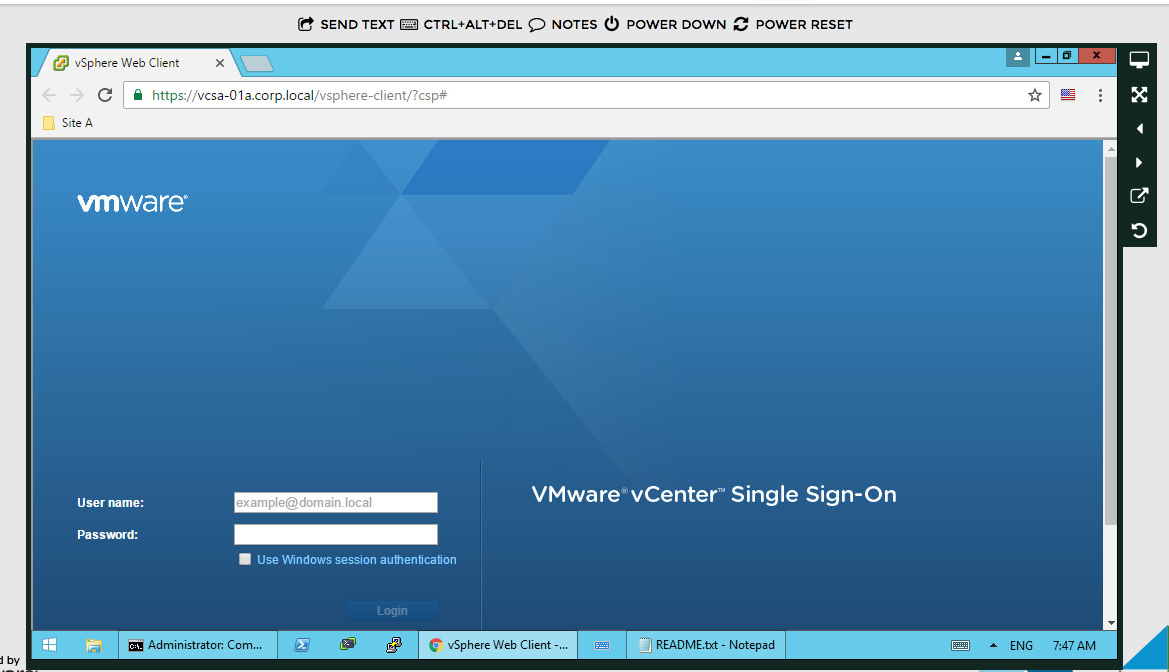

- #Install vmware esxi on laptop install#
- #Install vmware esxi on laptop iso#
- #Install vmware esxi on laptop free#
- #Install vmware esxi on laptop mac#
- #Install vmware esxi on laptop windows#
#Install vmware esxi on laptop iso#
iso image uploaded to the VMware host in the previous section the second one connected to the port group created in previous sections.the first one connected to a port group with an uplink to your network.
#Install vmware esxi on laptop mac#
add 2 NICs (both with MAC address = Automatic):. #Install vmware esxi on laptop free#
Select storage (which datastore you select is not important, just make sure it has sufficient free space for the storage defined in the table above)Ĭustomize settings as defined in screen shot below. Specify the name (see table above) and guest OS iso file to your laptop first and then upload it to your VMware ESXi host via the Datastore browser under the Storage left menu item.
#Install vmware esxi on laptop install#
On the bastion VM we'll install Centos 8 using the ISO image CentOS-8-x86_64-1905-dvd1.iso. Use the VMware ESXi web console to perform the following configuration steps: Upload Operating System binary
Virtual Switch = vSwitchocp67 (created in the previous section). Under the Networking left menu, add a Port Group with the following properties: remove the uplink (this switch is used for the internal OpenShift network and should access the internet via the bastion router). Under the Networking left menu, add a standard Virtual Switch with the following properties: Use the VMware ESXi web console to create a dedicated vSwitch and Port Group for our OpenShift environment: Create VMware ESXi vSwitch Configuration and Installation VMware ESXi Network To apply this solution to your environment, just replace all occurences of the hostname of our VMware lab server to the name of your VMware lab server. It also serves as gateway and router to the internet for the 192.168.67.0 subnet. It also hosts the TFTP and Matchbox servers to provision the OpenShift VMs. It hosts the DNS server, DHCP server and load balancer for a 192.168.67.0 subnet that will be created with the Virtual Switch vSwitchocp67. The following table summarizes the VMs that we use to deploy OpenShift: VM name The conceptual architecture of our single machine OpenShift cluster is depicted below: The installation was tested on VMware ESXi 6.5.0 (Dell-ESXi-6.5.0-4564106-A00 (Dell)) Solution Overview Two Dual Port Embedded Broadcom NetXtreme II 5709 Gigabit Ethernet NIC with TOE & iSCSI. 4 x 500GB, SATA, 2.5-in, 7.2K RPM Hard Drive (Hot Plug). 64GB Memory, DDR3, 1333MHz (16x4GB Dual Ranked RDIMMs). The machine we used to perform the installation is a Dell PowerEdge R715 rackserver, with the following specs: OpenShift Documentation: Installing a cluster on bare metal. OpenShift Blog: Deploying a UPI environment for OpenShift 4.1 on VMs and Bare Metal. ReferencesĪ quick search on the internet quickly returned a number of resources that provided the basis for our solution:  CodeReady does not contain all OpenShift featuresĪ similar existing VMWare ESXi environment was already available, which allowed us to design and validate the setup for the lab machine we wanted to migrate. a Linux server with matching requirements was not (yet) available.
CodeReady does not contain all OpenShift featuresĪ similar existing VMWare ESXi environment was already available, which allowed us to design and validate the setup for the lab machine we wanted to migrate. a Linux server with matching requirements was not (yet) available. 
#Install vmware esxi on laptop windows#
testing on a personal Windows laptop required Hyper-V, which would conflict with VirtualBox, our preferred hypervisor. This alternative needs further evaluation but was put on hold because: Therefore the standard vSphere installation instructions can not be used.Īnother alternative we considered was Red Hat CodeReady Containers. Our goal is to install Red Hat OpenShift on a single VMware ESXi machine, because this allows us to use the free VMware ESXi license, without a central vCenter server. The options we considered were:Īt first sight the installation instructions for vSphere seem to correspond with our use case, but this setup requires VMware vSphere vCenter, managing your VMware vSphere machines. on our labo server to replace Windows Server 2008. and was no longer being used.Īt the time of writing, the OpenShift installation was only supported out of the box on: This project was created because we wanted to install Red Hat OpenShift on an existing lab machine that was running an end of support Windows Server 2008 O.S. 
The configuration files and scripts used for the installation are also maintained by this project. This project documents how you can setup a complete Red Hat OpenShift 4.2 cluster on a single VMware ESXi host machine.








 0 kommentar(er)
0 kommentar(er)
